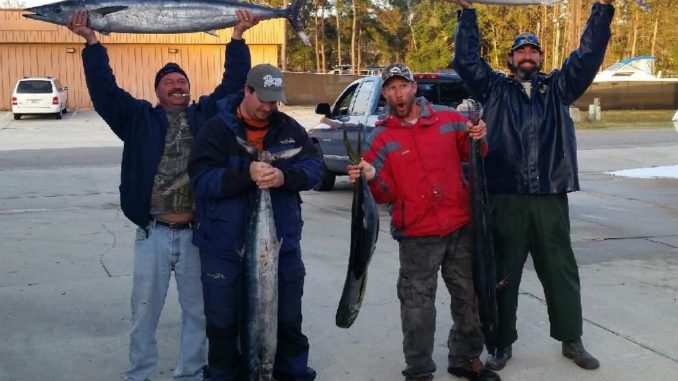
Temperature breaks are holding plenty of wahoo, and plenty of big ones
The season of giving continues into the New Year for anglers willing to brave the 60-mile journey to the blue waters at the Winyah Scarp, as fishermen are finding monster-sized wahoo and lots of them.
Lately, Captain Jay Sconyers of Aces Up Fishing out of Murrells Inlet has averaged several hundred pounds of wahoo on each trip over the past two weeks.
“The wahoo bite has been real strong lately. I have been catching four to five each trip,” said Sconyers (843-997-3270). “This time of year is always a great time to catch wahoo.”
Sconyers has been getting offshore whenever the weather permits, and fortunately, wahoo movements are a little easier to predict during bone-chilling weather. Water temperatures can become stratified, with a 20- to 30-degree difference between shallow, nearshore waters and the deep Gulf Stream. The complex mixture of currents defines major temperature breaks for large, apex predators such as wahoo, tuna and sharks.
Sconyers looks for warm ocean waters over ledges and other structure to find sizable groups of wahoo in the big blue sea.
“Just last week, I found 75- to 77-degree water at the Winyah Scarp. That is incredible for January,” said Sconyers, who relies heavily on sea-surface temperature charts published online by Rutgers University. Before he leaves the dock, he decides where he wants to start fishing based on up-to-date temperature readings, knowing that temperature breaks will concentrate baitfish, as well as wahoo and tuna.
“The key to great winter wahoo fishing is to find the concentrations of bait. Find the bait, and the fish will be there sooner or later,” he said.
As soon as Sconyers finds good pods of bait in an area, he will fish the area hard and will rarely leave.
“When I find a big chunk of bait, I just stay put. If the fish don’t bite immediately, they will soon enough,” he said.
Wahoo may not feed all day, but at some point, they will belly up to the dinner table when the buffet line remains fully stocked and steaming.
Sconyers is using plenty of different lures and color combinations and having good success from every end of the spectrum. Wahoo have been pummeling rigged ballyhoo pulled naked or behind multi-colored Sea Witches to high-speed trolling lures and splashers.




Be the first to comment